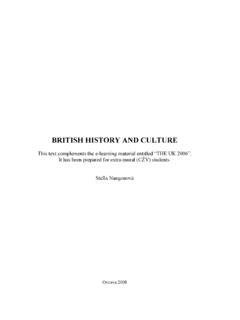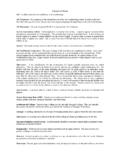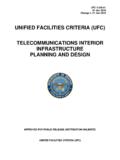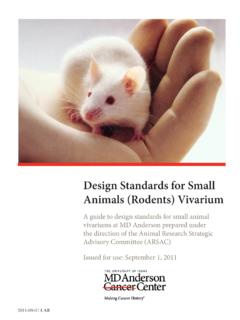Transcription of MOD Architectural Framework Concepts & Doctrine …
1 - 1 - MODAF- M10-013 MINISTRY OF DEFENCE MOD Architectural Framework Concepts & Doctrine Community of Interest Deskbook Draft 29 July 2005 Prepared by:- Approved by:- CROWN COPYRIGHT 2005. THIS DOCUMENT IS THE PROPERTY OF HER BRITANNIC MAJESTY S GOVERNMENT. This material (other than the Royal Arms and departmental or agency logos) may be reproduced free of charge in any format or medium provided it is reproduced accurately and not used in a misleading context. Where this material is being republished or copied to others, the source of the material must be identified and the copyright status acknowledged. For further information on Crown Copyright policy and licensing arrangements, see the guidance featured on the HMSO website - 2 - RECORD OF CHANGES This page will be updated and re-issued with each amendment. It provides an authorisation for the amendment and a checklist to the current amendment number. Issue No.
2 Date Revision Details Draft 29 July 2005 First Draft - 3 - Concepts & Doctrine MODAF Deskbook Table of Contents 1. 4 2. 5 What is MODAF?..5 Guide to 6 Purpose ..6 Context .. 6 Deskbook 8 3. MODAF Relationship to Concepts & Doctrine Processes and 9 Architecture Development 9 Six-Stage Architecture Development 9 Architectural Data 10 Application to Concepts & Doctrine 10 Overview of MODAF View 13 Ensuring Views are MODAF compliant - hybrid and modified 14 Concepts & Doctrine 14 16 Capability 16 Future Capability 17 Analytical concept 21 Capability Development and 21 Applied Capability Selection and 26 CADMID Validation and Oversight / LOD 28 In-Service Development of 28 4. Worked 33 5. Document Maintenance .. 34 - 4 - 1. Foreword (Generic foreword - championing the use of MODAF, covering mandation issues and policy, emphasis of the benefits of MODAF and an Architectural approach to be written by MOD) - 5 - 2.
3 Introduction What is MODAF? The MOD Architecture Framework (MODAF) is a Framework for conducting Enterprise Architecture and provides a means to model, understand, analyse and specify Capabilities, Systems, Systems of Systems (SoS) and Business Processes. MODAF consists of the six Viewpoints that are shown in Figure 2-1. Figure 2-1: MODAF Viewpoints MODAF uses six Viewpoints, each consisting of a number of modelling Views, to cover the complexity of MOD activities as shown in Figure 2-1. Not all MODAF Viewpoints and Views are needed for every architecture and it is intended that users select appropriate ones in order to most effectively represent their area of interest. MODAF may be applied across a wide variety of MOD processes, including capability management, acquisition, operational analysis, planning and through-life management. Applied appropriately MODAF should be an enabler to the successful delivery of Network Enabled Capability (NEC)1.
4 Amongst the benefits of MODAF within the Concepts & Doctrine processes are: Improved articulation of Concepts to identified defence capabilities Improved identification and management of cross-capability dependencies Better support for concept generation and capability development and assessment Ensure better capability selection, endorsement and integration across all DLODs. 1 CM(IS) NEC Next Steps paper of April 2003 SystemsViewpointArticulates system composition and interconnectivity to support system analysis, and through-life managementAcquisition ViewpointArticulates acquisition programme construct, timelines and DLOD status to inform planningAll ViewsProvides pertinent summary information that specifies the architecture productStrategic ViewpointArticulates the long-term strategic picture to support capability management and equipment planningTechnicalViewpointArticulates policy, standards, guidance & constraints to specify and assure quality expectationsOperational ViewpointArticulates the operational picture to support operational analysis, user requirements definition, and solution acceptance - 6 - Guide to Deskbook Purpose The purpose of this document is to.
5 Assist relevant members of the Concepts & Doctrine community to produce MODAF compliant architectures Illustrate to the general Concepts & Doctrine community how the MODAF Views within these architectures can support the various elements of their processes and activities. Context The Concepts & Doctrine Deskbook forms part of the overall suite of MODAF baseline documentation as shown in Figure 2-2. Figure 2-2: MODAF Baseline Products The main elements of the MODAF baseline documentation are: Executive Summary provides a brief summary of the entire MODAF baseline MODAF Overview describes what MODAF is, why it should be used and details the process for developing architectures MODAF Technical Handbook provides details of the construction of MODAF Views and their relationship to the MODAF meta model (M3). This is supported by: TaxonomyTaxonomyMeta ModelMeta ModelMODAF Acronyms ListMODAF Acronyms ListCOI COI DeskbooDeskbookkCOI COI DeskbooDeskbookkConcepts & Concepts & DoctrineDoctrineCOI COI DeskbooDeskbookkCOI COI DeskbooDeskbookkMODAFMODAFCOICOID eskbookDeskbookMODAFMODAFT echnical Technical HandbookHandbookMODAFMODAFO verviewOverviewMODAF Executive SummaryMODAF Executive SummaryViewViewOverviewOverviewViewViewO verviewOverviewMODAF Glossary of TermsMODAF Glossary of Terms Quick Start GuidesGuide - Developing Architectures - 7 - - View Overview a short summary of each View intended for quick reference by MOD users - Meta Model used to define the Architectural objects that are permitted in MODAF Views and their relationships with each other - Taxonomy provides the approved names and definitions for Architectural objects to be used within the MOD s architectures MODAF Deskbooks describe how users within particular communities in the MOD are
6 Expected to utilise MODAF architectures to support their processes. Each of the Deskbooks has one or more quick start guides that provide an easy reference summary of the relationship of MODAF Views to the community s processes For the purpose of describing the relationship of MODAF to MOD s processes, five communities of interest (COIs) have been considered as shown in Figure 2-3 below. Whilst these do not describe the whole of the MOD s processes as described in the Business Management System (BMS), they do cover the core processes around acquisition and military operations. Figure 2-3: Community of Interest Deskbook Scope The high level scope of these COIs is: Concepts and Doctrine the development of analytical Concepts ( Joint HLOC), applied Concepts ( Carrier Strike Concepts ) and in-service Doctrine , SOPs and TTPs Customer 1 the monitoring of capability gaps against future needs, building the Equipment Programme (EP)
7 And ownership of URDs for new capabilities Acquisition the development and fielding of new military capabilities, the primary focus is up to the acceptance into service of a fully operational capability C ADMC ADMITDIC oncepts & DoctrineCapabilityManagementOperationsFu ndedOptionsCapability GapsFuture OpNeedsDoctrineCustomer 1 AcquisitionSustainCustomer 2 Concepts & Doctrine - 8 - Sustain the processes to maintain and upgrade a military capability throughout its operational life Customer 2 the Front Line Commands planning and conducting their operational activities including their Core Leadership and Pivotal Management roles as defined in Smart Acquisition2 Deskbook Structure The remainder of the MODAF Concepts & Doctrine Deskbook comprises two key sections: Section 3 - MODAF s Relationship to the Concepts & Doctrine Processes and Activities this section explains the process of architecting as applied by those engaged in the Concepts & Doctrine process.
8 Specifically, it identifies the key processes and activities during development of Policy, Analytical and Applied Concepts and Doctrine and outlines how these align with the MODAF Viewpoints. Section 4 - Worked Example of MODAF in Concepts & Doctrine this section demonstrates how MODAF can be used practically within the Concepts & Doctrine community by means of a real-life architecture example. In addition, the following quick start guides are available that summarise key architecture elements of this Deskbook: Concepts Development Guide Doctrine Development Guide 2 See Smart Acquisition Handbook, available on the Acquisition Management System (AMS) at - 9 - 3. MODAF Relationship to Concepts & Doctrine Processes and Activities Architecture Development Process Six-Stage Architecture Development Process The approach to developing a MODAF-compliant architecture is shown in Figure 3-1 This shows how a MODAF user within any community in the MOD goes about establishing the intended use, scope and data requirements, developing the architecture, using this to conduct the required analyses and documenting the results.
9 A more detailed description of this six-stage architecture development process is provided in the Overview of MODAF (MODAF-M07-020). Figure 3-1 : General Process for Building MODAF-Compliant Architectures In addition to showing the steps that a MODAF user should follow, Figure 3-1 also highlights the MODAF resources that are available to help them and the key interactions that are required with the MODAF governance processes. One of the key MODAF governance mechanisms is the MOD Architectural repository (MODAR) that is run by the Integration Authority (IA). This can be used to run queries and extract existing Architectural data such as information on the systems that a new capability has to interface with. It is also important that all new architectures are lodged with MODAR to inform others and allow the re-use of new Architectural data. Furthermore, for the Acquisition community the IA provides additional integration services that assist in modelling end-to-end performance and interoperability assurance.
10 Another key resource will be the list of certified tools. The MODAF tool certification scheme is still being developed at the time of this MODAF baseline issue, definitive User training- MODAF principlesPrerequisites1. Establish Intended Use2. Define Architecture Scope3. Develop Data Requirements4. Capture Architecture5. Conduct Analyses6. Document ResultsMODAF GovernanceMODAF UsersMODAF ResourcesMODAF BaselineArchitectural Use -Determine Architecture UsageWorkshop -Bound Architecture ScopeWorkshop -Establish Data NeedsArchitectural Scope SelectionData Gathering PlanBaselineArch. ReviewBaseline ArchitectureInform Central of Avail. Data SourcesPublish Baseline to MODARTool-specific TrainingInitial AnalysisFinal AnalysisAnalysis ReviewFinalised ArchitectureFinalised Arch. ReviewPublish Final Arch. to MODARP rovide Extant Training MaterialMODAF Tiger TeamsMODAF Tiger TeamsMODAF Help DeskMODAF Help DeskMODAF Help DeskMODAF Help DeskMODAF Help DeskMODAF Help DeskMODAF Tiger TeamsCertified Tool ListTool AdviceHybrid View DevelopmentMODAF Tiger TeamsMODAF Tiger TeamsMODAF Tiger TeamsMODAF TaxonomyERM / M3 Workshop -Determine Use CasesPlan of Time & Resources - 10 - guidance as to tool availability and fit with different COIs is not currently available.







